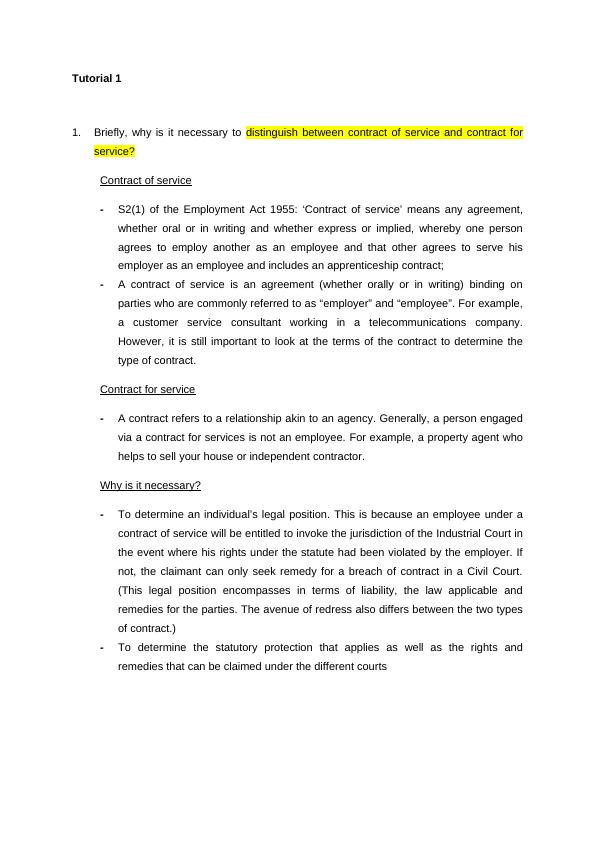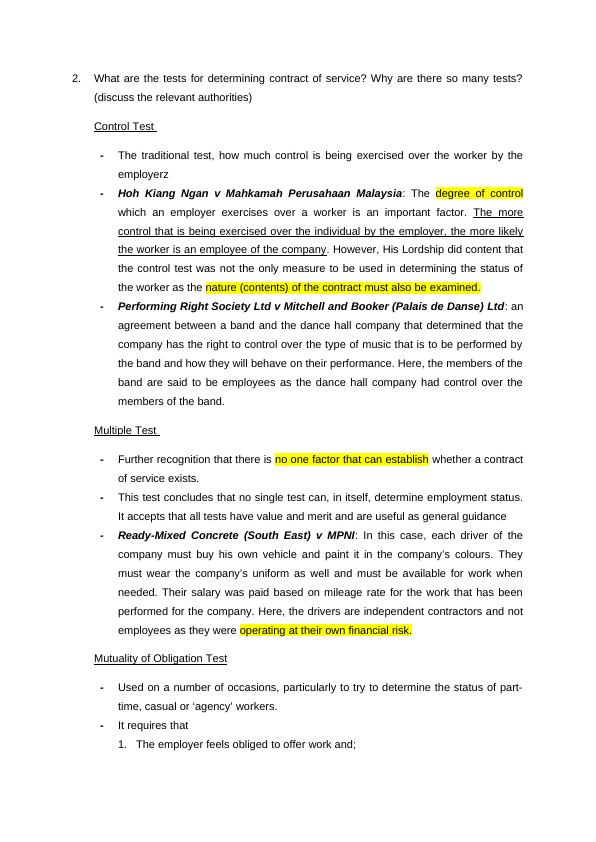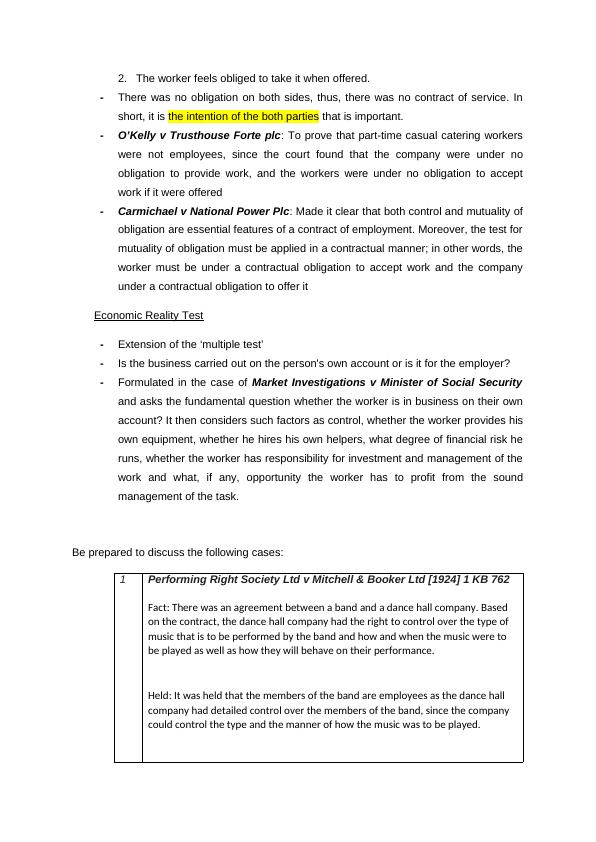Ask a question from expert
Employment Act 1955 - Assignment
9 Pages2952 Words575 Views
Added on 2021-07-07
Employment Act 1955 - Assignment
Added on 2021-07-07
BookmarkShareRelated Documents
Tutorial 1 1.Briefly, why is it necessary to distinguish between contract of service and contract forservice?Contract of service-S2(1) of the Employment Act 1955: ‘Contract of service’ means any agreement,whether oral or in writing and whether express or implied, whereby one personagrees to employ another as an employee and that other agrees to serve hisemployer as an employee and includes an apprenticeship contract;-A contract of service is an agreement (whether orally or in writing) binding onparties who are commonly referred to as “employer” and “employee”. For example,a customer service consultant working in a telecommunications company.However, it is still important to look at the terms of the contract to determine thetype of contract.Contract for service-A contract refers to a relationship akin to an agency. Generally, a person engagedvia a contract for services is not an employee. For example, a property agent whohelps to sell your house or independent contractor.Why is it necessary?-To determine an individual’s legal position. This is because an employee under acontract of service will be entitled to invoke the jurisdiction of the Industrial Court inthe event where his rights under the statute had been violated by the employer. Ifnot, the claimant can only seek remedy for a breach of contract in a Civil Court.(This legal position encompasses in terms of liability, the law applicable andremedies for the parties. The avenue of redress also differs between the two typesof contract.)-To determine the statutory protection that applies as well as the rights andremedies that can be claimed under the different courts

2.What are the tests for determining contract of service? Why are there so many tests?(discuss the relevant authorities)Control Test -The traditional test, how much control is being exercised over the worker by theemployerz-Hoh Kiang Ngan v Mahkamah Perusahaan Malaysia: The degree of controlwhich an employer exercises over a worker is an important factor. The morecontrol that is being exercised over the individual by the employer, the more likelythe worker is an employee of the company. However, His Lordship did content thatthe control test was not the only measure to be used in determining the status ofthe worker as the nature (contents) of the contract must also be examined.-Performing Right Society Ltd v Mitchell and Booker (Palais de Danse) Ltd: anagreement between a band and the dance hall company that determined that thecompany has the right to control over the type of music that is to be performed bythe band and how they will behave on their performance. Here, the members of theband are said to be employees as the dance hall company had control over themembers of the band.Multiple Test -Further recognition that there is no one factor that can establish whether a contractof service exists. -This test concludes that no single test can, in itself, determine employment status.It accepts that all tests have value and merit and are useful as general guidance-Ready-Mixed Concrete (South East) v MPNI: In this case, each driver of thecompany must buy his own vehicle and paint it in the company’s colours. Theymust wear the company’s uniform as well and must be available for work whenneeded. Their salary was paid based on mileage rate for the work that has beenperformed for the company. Here, the drivers are independent contractors and notemployees as they were operating at their own financial risk. Mutuality of Obligation Test-Used on a number of occasions, particularly to try to determine the status of part-time, casual or ‘agency’ workers. -It requires that1.The employer feels obliged to offer work and;

2.The worker feels obliged to take it when offered.-There was no obligation on both sides, thus, there was no contract of service. Inshort, it is the intention of the both parties that is important.-O’Kelly v Trusthouse Forte plc: To prove that part-time casual catering workerswere not employees, since the court found that the company were under noobligation to provide work, and the workers were under no obligation to acceptwork if it were offered-Carmichael v National Power Plc: Made it clear that both control and mutuality ofobligation are essential features of a contract of employment. Moreover, the test formutuality of obligation must be applied in a contractual manner; in other words, theworker must be under a contractual obligation to accept work and the companyunder a contractual obligation to offer itEconomic Reality Test-Extension of the ‘multiple test’ -Is the business carried out on the person's own account or is it for the employer?-Formulated in the case of Market Investigations v Minister of Social Securityand asks the fundamental question whether the worker is in business on their ownaccount? It then considers such factors as control, whether the worker provides hisown equipment, whether he hires his own helpers, what degree of financial risk heruns, whether the worker has responsibility for investment and management of thework and what, if any, opportunity the worker has to profit from the soundmanagement of the task.Be prepared to discuss the following cases:1Performing Right Society Ltd v Mitchell & Booker Ltd [1924] 1 KB 762Fact: There was an agreement between a band and a dance hall company. Based on the contract, the dance hall company had the right to control over the type of music that is to be performed by the band and how and when the music were to be played as well as how they will behave on their performance. Held: It was held that the members of the band are employees as the dance hall company had detailed control over the members of the band, since the company could control the type and the manner of how the music was to be played.

End of preview
Want to access all the pages? Upload your documents or become a member.
Related Documents
LAWS5555 - Employee Relations Law Assignmentlg...
|10
|3233
|123
University of Bristol - Case Study Of Law | Vicarious Liabilitylg...
|11
|2612
|117
The Employment Status - Assignmentlg...
|8
|2046
|84
Difference between employee and independent contractor | Lawlg...
|7
|1133
|312
BSL202 Workplace Law: Assignmentlg...
|10
|2205
|287
Business Law Presentationlg...
|10
|615
|48